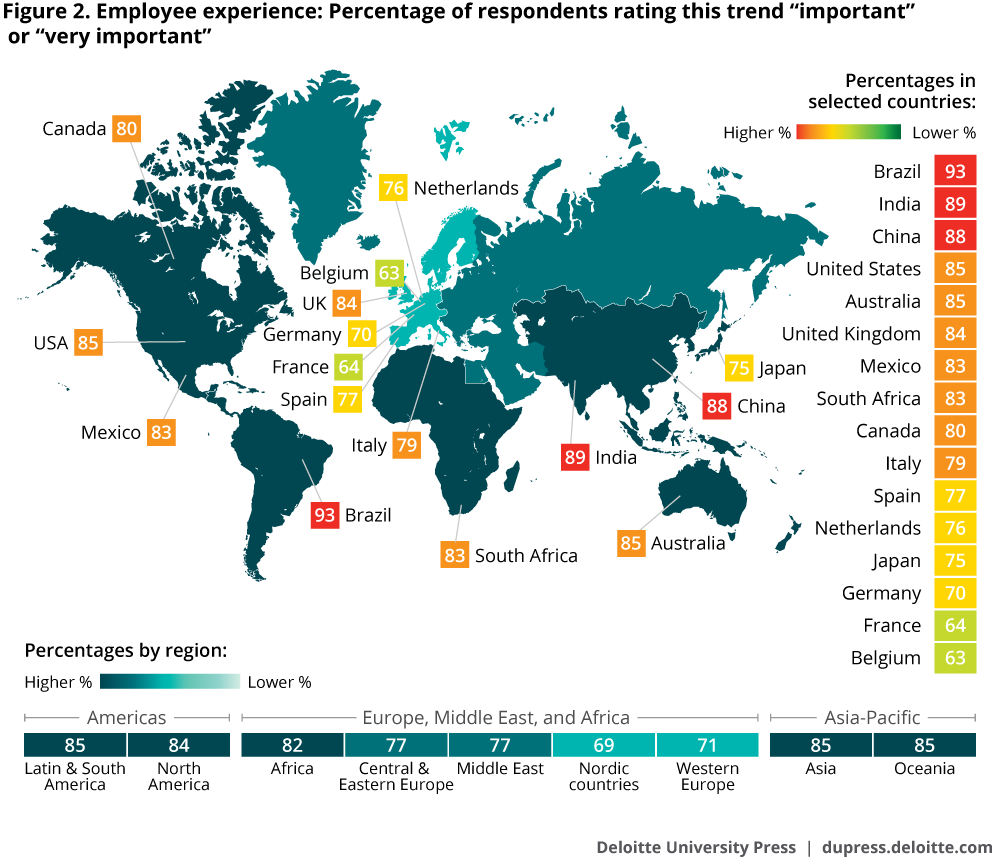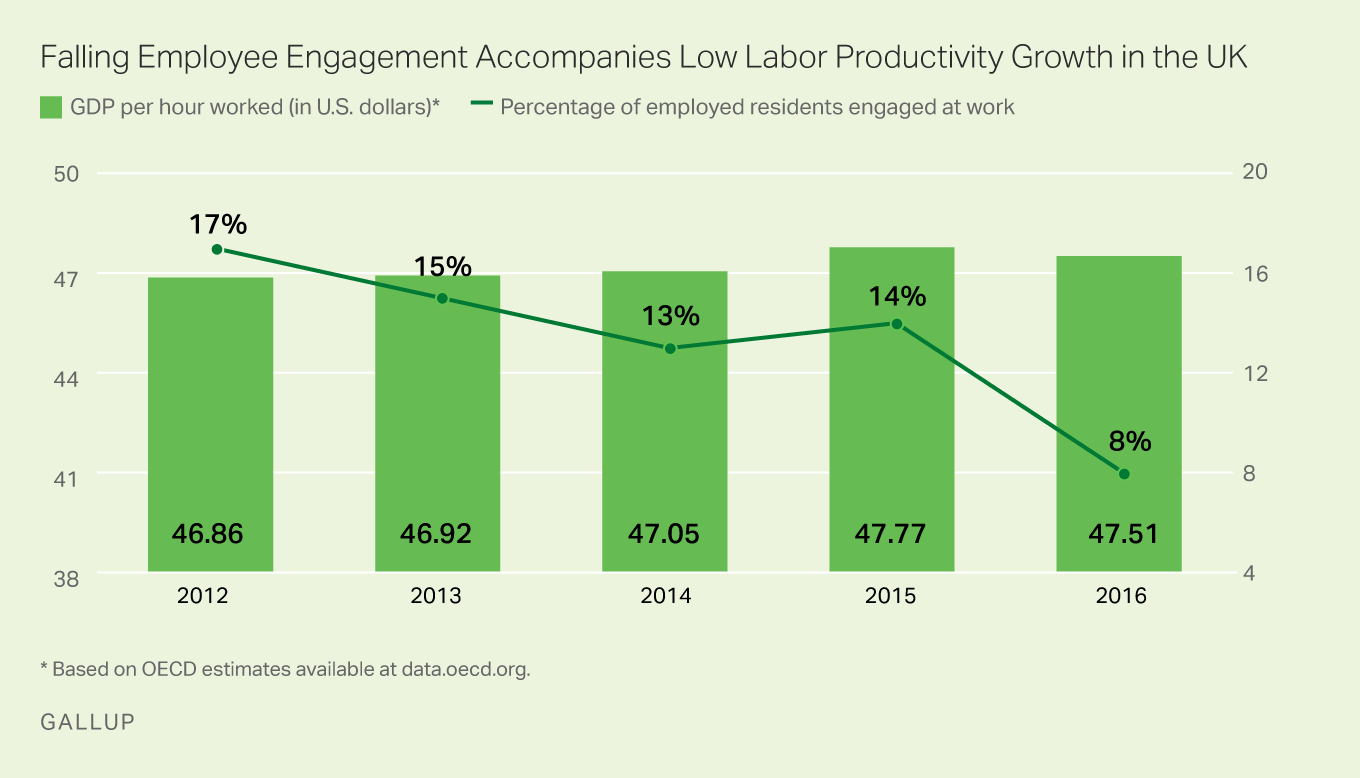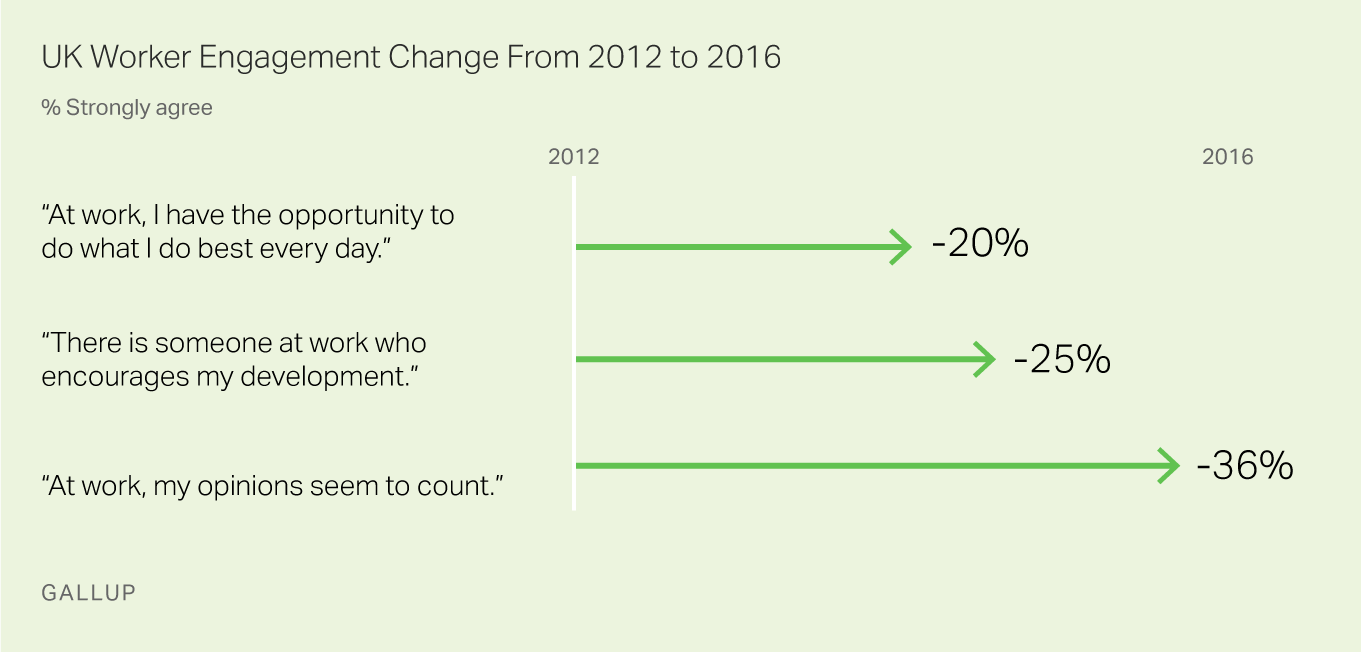Transform Your Employee Experience
In a digital world with increasing transparency, employees expect an engaging, productive and enjoyable experience at work. A narrow focus on engagement and culture is shifting towards an integrated focus on the entire employee experience – spanning all of the workplace, HR, and management practices that impact employees. In striving to understand and improve the experience, HR teams are now aided by new tools such as pulse feedback, wellness and fitness apps, and integrated employee self-service tools. In some quarters, employee net promoter scores are being used to measure employee satisfaction.
Deloitte’s 2017 Global Human Capital Trends survey polled ten thousand business and HR heads in 140 countries globally. Of note, nearly 80% of executives rated employee experience very important (42%) or important (38%), but only 22% reported that their companies were excellent at building a differentiated employee experience. And 59% of respondents reported they were not ready or only somewhat ready to address the employee experience challenge.
Nearly 50% of all surveyed companies are currently attempting to change their culture in response to shifting talent markets and increased competition.
Few factors contribute more to business success than culture. In the new era of instant information and hence brand transparency, great companies consciously cultivate and manage their culture as a competitive advantage in the marketplace. Just as marketing and product teams have moved beyond customer satisfaction to look at total customer experience, so HR is refocusing its efforts on building programs, strategies, and teams that understand and continuously improve the entire employee experience.
The problems of employee engagement and productivity continue to grow and as an indication of just how complex the work environment has become, overall employee engagement, as measured by Glassdoor data across thousands of companies, is flat year over year. This year’s Global Human Capital Trends research shows that companies’ ability to address these issues of engagement and culture has actually dropped by 14% since last year.

Culture describes “the way things work around here.” It includes everything that influence people’s behaviour on a day-to-day basis. It is a CEO-level issue and needs to be driven and embedded by top leadership.
Engagement describes “how people feel about the way things work around here.” It indicates the level of employee commitment to the company and to their work. When engagement is poor, employees feel uneasy or uncommitted and the results can be easily viewed in terms of employee turnover, performance, and low levels of innovation and customer service. Fewer than 12% of companies believe that they truly understand their culture. Interestingly, without a clearly defined culture which is understood and upheld across the organisation, all kinds of processes are impacted and can make it even more difficult to embed one: hiring, promotions, compensation and promotion.
According to Gallup, a staggering 85% of employees worldwide are not engaged. With so many companies focused on engaging their employees, why aren’t engagement levels increasing? Many companies that Gallup have consulted with now have a workforce made up of at least 75% of engaged employees – a few even higher than that. But these success stories are very isolated. So why have some companies massively boosted their number of engaged employees, while others have not? It comes down to two reasons.
- An employee engagement program needs to be a manager education and development initiative, not a measurement initiative. But many are really just the latter. An annual survey by itself does not help anyone. The survey should be just an audit of whether things are getting better. But the program should be all about providing managers with learning and tools to increase engagement within their teams, week in and week out – through ongoing conversations between managers and their employees. Many companies simply conduct an annual survey and more or less tell managers to “get better,” but they don’t sufficiently follow up. This has never worked and will never work. It’s not what the most successful firms
- Companies are not nearly selective enough about whom they name as their managers, at every level. Most people become managers either because they were top individual performers or because they’ve been around the company a long time. Neither of those two things has ever shown a strong correlation with being a good manager. In fact, Gallup research has found that only 10% of human beings are naturally wired to be great managers — and some others, while not naturally gifted, are teachable. But companies choose candidates with the right talent for the job only 18% of the time.
While great manager education and development can help almost anyone be a better manager, it works a lot better if you invest heavily in people who are already wired to be great in the role. There are scientific ways to accomplish this: psychological assessments, better interviewing questions by hiring managers, etc. Companies need to use this science.
Major Challenges in UK
Since 2012, Gallup has tracked a number of workplace metrics among employed Britons – including employee engagement. These metrics are an index of workplace perceptions that are consistently predictive of positive business outcomes. Data from Gallup’s 2016 survey would suggest that not only is much of the British labor force poorly managed, but that the problem is actually getting worse. The data indicates that just 8% of employed Britons are engaged at work, down from 17% in 2012.

In other words, about one in twelve British employees are highly involved in and enthusiastic about their work and workplaces. The bulk of employees in the U.K. – 73% – are classified as “not engaged,” meaning they are psychologically unattached and putting little energy or passion into their work. The remaining 19% are “actively disengaged,” resentful that their workplace needs aren’t being met and likely to be acting out their unhappiness on the job.
How does this compare to other countries?
At 33%, U.S. employees studied in 2016 were four times as likely as British employees to be engaged at work. Employee engagement results are uniformly worse in Europe than the U.S.. Rates of GDP per hour worked were significantly higher in the U.S., Norway, Denmark, Sweden and Germany than in the U.K.
Percentage of Employees Who Are Engaged at Work: U.S. and Selected European Countries, 2016
(Source: Gallup)
Engaged employees
| % | |
|---|---|
| US | 33 |
| Denmark | 17 |
| Norway | 17 |
| Sweden | 15 |
| Germany | 13 |
| Finland | 13 |
| Netherlands | 12 |
| Belgium | 10 |
| U.K. | 8 |
| Spain | 6 |
| Italy | 4 |
| France | 3 |
There’s little doubt that the lack of intrinsic motivation, as signalled by low engagement scores, affects labor productivity. Gallup’s analysis, which included more than 82,000 business units in 73 countries across 49 industries, found that units in the top quartile of engagement scores were 17% more productive and 21% more profitable than those in the bottom quartile.
Unfortunately, British workplaces appear to be headed in the wrong direction as compared with 2012 data (see diagram)
Whilst it’s difficult to pinpoint the precise reasons for the discontent in the UK, one conclusion seems clear: many firms need to consider the extent to which bad managers are hindering their team’s performance.
In that light, it’s little wonder that managers in the U.K. are still often thought of as hapless administrators rather than as the gifted coaches that truly effective modern managers must be.
Gallup’s research demonstrates that traditional approaches to people management – characterised by hierarchical employee-manager relationships and annual performance reviews – no longer motivate employees. Younger workers in particular place a heavy premium on jobs that provide them with developmental opportunities, and managers who help them make the most of those opportunities.
From Manager to Coach
Firms can meet this challenge by prioritising employee development rather than sticking with what is increasingly an outdated performance management mentality. Managers can be trained as coaches or increase their efficacy by following some simple guidelines for interactions with their team, including:
1. Clarity. Good managers not only set clear expectations, they also give their employees a voice in the goal-setting process and clearly articulate how their individual expectations align with the organisation’s overall goals.
2. Continually coaching employees. The traditional employee feedback process places a great deal of emphasis on a single annual review. But performance is a continuum: it happens every day. Continual coaching between manager and employee generates an ongoing conversation about performance expectations and development needs. Great coaching conversations actually empower the employee and the relationship.
3. Creating meaningful accountability. In addition to maintaining an ongoing dialogue with employees, managers should complete at least two formal progress reviews with employees per year. Managers should ensure these reviews celebrate employee achievements, are perceived as fair and accurate, and include discussion of progress toward employees’ developmental goals.
Great coaches tend to be those managers who take the time to connect with their team members authentically and individually. They value how their employees naturally think and behave and use that information to match them with assignments and projects that energise them.
These coaches also know that engaging employees is not just about making them happy but ensuring that they have what they need to be successful in their roles and longer term career objectives. To this end, managers who excel at coaching have learned how to lead strengths-based and engagement-focused conversations.
The best coaches also know how to make the most out of their interactions. From an employee’s first day on the job to quick check-ins to formal progress discussions, managers who have effective performance conversations aren’t waiting for an annual review to discuss employee needs, successes or opportunities. They are actively involved in the process, day in and day out.
If this article resonates with you, please consult us about coach-mentor training and our experiences to date.

